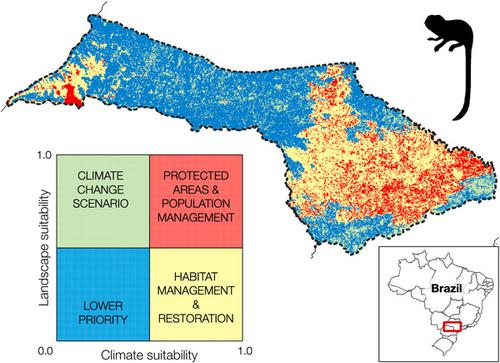当前位置:
X-MOL 学术
›
Am. J. Primatol.
›
论文详情
Our official English website, www.x-mol.net, welcomes your feedback! (Note: you will need to create a separate account there.)
Integrating climate and landscape models to prioritize areas and conservation strategies for an endangered arboreal primate
American Journal of Primatology ( IF 2.4 ) Pub Date : 2020-10-11 , DOI: 10.1002/ajp.23202 Gabriela Rezende 1, 2 , Thadeu Sobral‐Souza 3 , Laurence Culot 4
American Journal of Primatology ( IF 2.4 ) Pub Date : 2020-10-11 , DOI: 10.1002/ajp.23202 Gabriela Rezende 1, 2 , Thadeu Sobral‐Souza 3 , Laurence Culot 4
Affiliation

|
Species distributions are influenced by both climate conditions and landscape structure. Here we propose an integrated analysis of climatic and landscape niche‐based models for a forest‐dependent primate, the endangered black lion tamarin (Leontopithecus chrysopygus). We applied both climate and landscape variables to predict the distribution of this tamarin and used this information to prioritize strategic areas more accurately. We anticipated that this approach would be beneficial for the selection of pertinent conservation strategies for this flagship species. First, we built climate and landscape niche‐based models separately, combining seven algorithms, to infer processes acting on the species distribution at different scales. Subsequently, we combined climate and landscape models using the EcoLand Analysis. Our results suggest that historic and current landscape fragmentation and modification had profoundly adverse effects on the distribution of the black lion tamarins. The models indicated just 2096 km2 (out of an original distribution of 92,239 km2) of suitable areas for both climate and landscape. Of this suitable area, the species is currently present in less than 40%, which represents less than 1% of its original distribution. Based on the combined map, we determined the western and southeast regions of the species range to be priority areas for its conservation. We identified areas with high climatic and high landscape suitability, which overlap with the remaining forest fragments in both regions, for habitat conservation and population management. We suggest that areas with high climatic but low landscape suitability should be prioritized for habitat management and restoration. Areas with high landscape suitability and low climatic suitability, such as the Paranapiacaba mountain range should be considered in light of projected climate change scenarios. Our case study illustrates that a combined approach of climatic and landscape niche‐based modeling can be useful for establishing focused conservation measures that may increase the likelihood of success.
中文翻译:

整合气候和景观模型,以优先处理濒临灭绝的树栖灵长类动物的区域和保护策略
物种分布受气候条件和景观结构的影响。在这里,我们提出了一种针对以森林为基础的灵长类动物(濒临灭绝的黑狮猴(Leontopithecus chrysopygus))的基于气候和景观生态位模型的综合分析。我们使用气候和景观变量来预测这种绢毛猴的分布,并使用此信息来更准确地确定战略区域的优先级。我们预计,这种方法将有助于选择该旗舰物种的相关保护策略。首先,我们分别构建了基于气候和景观生态位的模型,结合了7种算法,以推断对不同规模物种分布起作用的过程。随后,我们使用生态土地分析。我们的结果表明,历史和当前的景观破碎化和修改对黑狮猴的分布产生了深远的不利影响。模型仅显示2096 km 2(原始分布为92,239 km 2)适合气候和景观的区域。在这个合适的区域中,该物种目前的存在量不到40%,占其原始分布的不到1%。根据组合图,我们将物种范围的西部和东南部区域确定为其保护的优先区域。我们确定了气候和景观适宜性高的区域,这些区域与两个地区的其余森林碎片重叠,用于栖息地保护和人口管理。我们建议应优先考虑气候条件适宜但景观适宜性较低的地区,以进行栖息地管理和恢复。应根据预计的气候变化方案,考虑具有高景观适应性和低气候适应性的区域,例如Paranapiacaba山脉。
更新日期:2020-11-19
中文翻译:

整合气候和景观模型,以优先处理濒临灭绝的树栖灵长类动物的区域和保护策略
物种分布受气候条件和景观结构的影响。在这里,我们提出了一种针对以森林为基础的灵长类动物(濒临灭绝的黑狮猴(Leontopithecus chrysopygus))的基于气候和景观生态位模型的综合分析。我们使用气候和景观变量来预测这种绢毛猴的分布,并使用此信息来更准确地确定战略区域的优先级。我们预计,这种方法将有助于选择该旗舰物种的相关保护策略。首先,我们分别构建了基于气候和景观生态位的模型,结合了7种算法,以推断对不同规模物种分布起作用的过程。随后,我们使用生态土地分析。我们的结果表明,历史和当前的景观破碎化和修改对黑狮猴的分布产生了深远的不利影响。模型仅显示2096 km 2(原始分布为92,239 km 2)适合气候和景观的区域。在这个合适的区域中,该物种目前的存在量不到40%,占其原始分布的不到1%。根据组合图,我们将物种范围的西部和东南部区域确定为其保护的优先区域。我们确定了气候和景观适宜性高的区域,这些区域与两个地区的其余森林碎片重叠,用于栖息地保护和人口管理。我们建议应优先考虑气候条件适宜但景观适宜性较低的地区,以进行栖息地管理和恢复。应根据预计的气候变化方案,考虑具有高景观适应性和低气候适应性的区域,例如Paranapiacaba山脉。



























 京公网安备 11010802027423号
京公网安备 11010802027423号